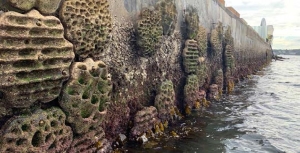Displaying items by tag: seawalls
$9m funding to revive Sydney Harbour biodiversity
In August the NSW Environment Minister, James Griffin, announced a project, dubbed the Seabirds to Seascapes project that aims to restore Sydney Harbour by bringing back lost biodiversity, improving water quality and increasing carbon storage. The project will restore habitats for some of our iconic species such as penguins, seals, seahorses and turtles
This project includes three elements:
- restoring Sydney Harbour's marine ecosystems by installing living seawalls, and replanting seagrass meadows and kelp forests
- supporting the future of little penguins by conducting the first ever state-wide little penguin census to better understand their population size and how they're responding to threats such as climate change, along with the restoration of seagrass meadows and kelp where they thrive
- helping fur seals thrive as a species by conducting a seal survey to identify their preferred habitat, breeding grounds, diet and key threats – seal numbers are growing, as evidenced by more sightings around the harbour and along the coast
The NSW Environmental Trust is granting $6.6m to the project, with partners contributing a further $2.5m in kind. The project is being led by the NSW Department of Planning and Environment, in partnership with the Sydney Institute of Marine Science (SIMS – see note below), Taronga Conservation Society Australia and NSW National Parks and Wildlife Service.
Note: SIMS is a collaborative marine science hub between UNSW Sydney, UTS, University of Sydney and Macquarie University. SIMS has more than 100 scientists and graduate students associated with the Institute, representing a broad diversity of skills in marine science.
Living Seawalls, an award-winning innovation
The world has been experiencing a construction boom in our seas. Globally, the area of the seafloor impacted by built infrastructure is greater than the area of the world’s mangrove and seagrass forests. Structures such as seawalls, pilings, pontoons and marinas are built for diverse purposes such as shoreline protection, recreational activities and energy generation, but lack the complexity required for a biodiverse marine environment. In particular, the flat and featureless surfaces of marine constructions provide little space for marine plants and animals to live, and few protective refuges from predators and environmental stressors, driving this reduced diversity and favouring the presence of pest species.
By blending ecological concepts and engineering in creative design, a team from SIMS is reviving our increasingly urbanised oceans through the development of affordable, adaptable and scalable methods of ecologically enhancing structures. Living Seawalls has shown that, despite marine construction being a large part of the problem, it can also be part of the solution.
The addition of living seawalls creates surface texture and microhabitats for organisms like shellfish, mussels and algae, which can regrow significantly in a year.
Living seawalls will be installed across nine locations in the harbour, where hundreds of kilometres of smooth harbour walls have made it difficult for organisms to take hold.
The Living Seawalls project (www.livingseawalls.com.au) has won the 2022 Banksia Foundation Award for Biodiversity. They have been installed in Singapore, Europe and two other locations in Australia. See.
Seagrass meadows, a vital habitat
Seagrasses (Posidonia australis) provide critical habitat for conservation icons like seahorses, as well as acting as nursery grounds for many fish species. They are very effective at capturing carbon as they can store carbon at up to 40 times faster than terrestrial forests.
These marine plants grow in shallow estuary waters. They have become severely threatened by human activities like coastal development, boat anchorages, pollution and sedimentation. The decline in these meadows has been so severe that six meadows have been formally listed as endangered under the Commonwealth Government (EPBC Act) and the NSW government.
Part of the replanting program involves asking local communities to collect shoots that naturally become detached after large storms.
Kelp forests
Crayweed (Phyllospora comosa) is a golden seaweed that forms extensive underwater forests and promotes biodiversity by providing habitat, food and shelter for hundreds of species, including crayfish and abalone. They also act as underwater forests, capturing carbon and creating oxygen.
However, crayweed completely disappeared from the Sydney metropolitan region from Palm Beach to Cronulla in the 1980s due to pollution and has never returned.












